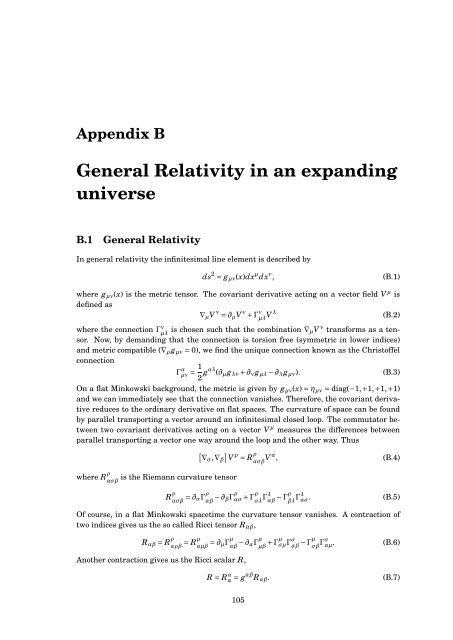Master's Thesis in Theoretical Physics - Universiteit Utrecht
Master's Thesis in Theoretical Physics - Universiteit Utrecht
Master's Thesis in Theoretical Physics - Universiteit Utrecht
Create successful ePaper yourself
Turn your PDF publications into a flip-book with our unique Google optimized e-Paper software.
Appendix BGeneral Relativity <strong>in</strong> an expand<strong>in</strong>guniverseB.1 General RelativityIn general relativity the <strong>in</strong>f<strong>in</strong>itesimal l<strong>in</strong>e element is described byds 2 = g µν (x)dx µ dx ν ,(B.1)where g µν (x) is the metric tensor. The covariant derivative act<strong>in</strong>g on a vector field V µ isdef<strong>in</strong>ed as∇ µ V ν = ∂ µ V ν + Γ ν µλ V λ(B.2)where the connection Γ ν µλ is chosen such that the comb<strong>in</strong>ation ∇ µV ν transforms as a tensor.Now, by demand<strong>in</strong>g that the connection is torsion free (symmetric <strong>in</strong> lower <strong>in</strong>dices)and metric compatible (∇ ρ g µν = 0), we f<strong>in</strong>d the unique connection known as the ChristoffelconnectionΓ α µν = 1 2 gαλ (∂ µ g λν + ∂ ν g µλ − ∂ λ g µν ).(B.3)On a flat M<strong>in</strong>kowski background, the metric is given by g µν (x) = η µν = diag(−1,+1,+1,+1)and we can immediately see that the connection vanishes. Therefore, the covariant derivativereduces to the ord<strong>in</strong>ary derivative on flat spaces. The curvature of space can be foundby parallel transport<strong>in</strong>g a vector around an <strong>in</strong>f<strong>in</strong>itesimal closed loop. The commutator betweentwo covariant derivatives act<strong>in</strong>g on a vector V µ measures the differences betweenparallel transport<strong>in</strong>g a vector one way around the loop and the other way. Thus[∇σ ,∇ β]V ρ = R ρ ασβ V α , (B.4)where R ρ is the Riemann curvature tensorασβR ρ ασβ = ∂ σΓ ρ αβ − ∂ βΓ ρ ασ + Γ ρ σλ Γλ αβ − Γρ βλ Γλ ασ .(B.5)Of course, <strong>in</strong> a flat M<strong>in</strong>kowski spacetime the curvature tensor vanishes. A contraction oftwo <strong>in</strong>dices gives us the so called Ricci tensor R αβ ,R αβ = R ρ αρβ = Rµ αµβ = ∂ µΓ µ αβ − ∂ αΓ µ µβ + Γµ σµΓ σ αβ − Γµ σβ Γσ αµ .(B.6)Another contraction gives us the Ricci scalar R,R = R α α = gαβ R αβ .(B.7)105
















